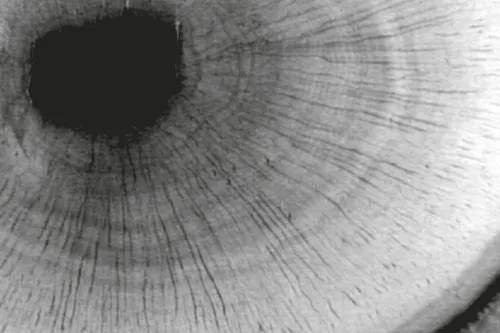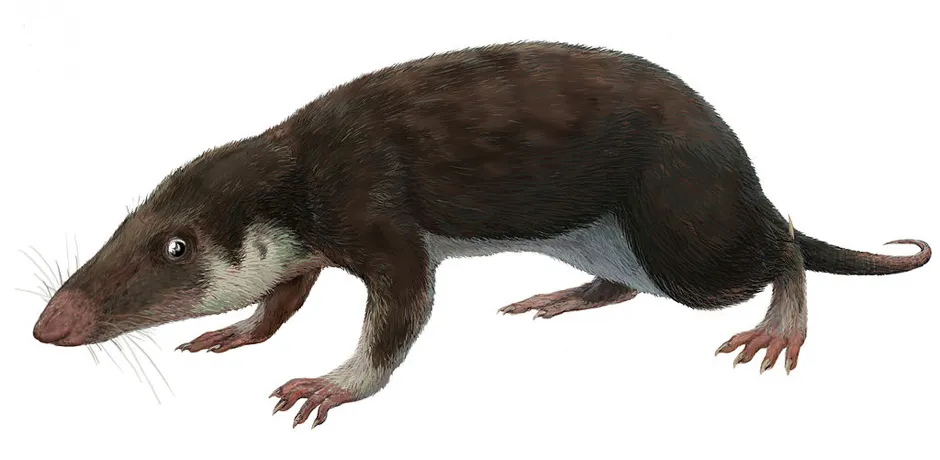Analysis of teeth dating back 200 million years suggests that the earliest mammals functioned like reptiles – leading less active but much longer lives.
The research, led by the University of Bristol and University of Helsinki in Finland, is the first time palaeontologists have been able to study the physiologies of early fossil mammals directly.
Fossils of teeth from two of the earliest mammals, Morganucodon and Kuehneotherium, which roamed the earth alongside early dinosaurs, were scanned using X-rays.

Researchers studied growth rings in the tooth sockets – deposited each year like tree rings – that could be counted to reveal how long the animals lived.
The results, published in Nature Communications, indicated a maximum lifespan of up to 14 years for the animals –much older than their similarly sized furry successors, such as mice and shrews, which tend to only survive for a year or two in the wild.
Read more fossil discoveries:
- Fossilised dinosaur skull reveals adorable appearance of baby sauropods
- Ancient reptile ‘well-preserved’ in stomach of slightly larger reptile
- 200 million-year-old fossil shows dinosaur 'walked like a guineafowl'
“We made some amazing and very surprising discoveries,” said Dr Elis Newham, research associate at the University of Bristol. It was thought the key characteristics of mammals, including their warm-bloodedness, evolved at around the same time.
“By contrast, our findings clearly show that, although they had bigger brains and more advanced behaviour, they didn’t live fast and die young but led a slower-paced, longer life akin to those of small reptiles, like lizards.”
Dr Pam Gill, senior research associate at the University of Bristol, was inspired to use advanced imaging technology on the teeth after a colleague had a tooth removed. They told Dr Gill they wanted to get their tooth X-rayed, as it could reveal information about a person’s life history.
“That got me wondering whether we could do the same to learn more about ancient mammals,” Dr Gill said.
The theory was that scanning the fossilised cementum – the material which locks the tooth roots into their socket in the gum and continues growing throughout life – would determine a mammal’s lifespan.
To test it, an ancient tooth specimen belonging to Morganucodon was sent to Dr Ian Corfe from the University of Helsinki.
Dr Corfe used high-powered Synchrotron X-ray radiation to scan the tooth. “To our delight, although the cementum is only a fraction of a millimetre thick, the image from the scan was so clear the rings could literally be counted,” Dr Corfe said.
The discovery marked the start of a six-year international study that focused on Morganucodon and Kuehneotherium, known from Jurassic rocks in south Wales and dating back nearly 200 million years.
Morganucodon and Kuehneotherium fell into caves and holes in the rock where their skeletons, including their teeth, fossilised.
Read more about Jurassic dinosaurs:
- Cannibal dinosaurs may once have roamed late-Jurassic Earth
- The Isle of Skye was a Middle-Jurassic dinosaur hotspot
- Five real Jurassic Park dinosaurs
“Thanks to the incredible preservation of these tiny fragments, we were able to examine hundreds of individuals of a species, giving greater confidence in the results than might be expected from fossils so old,” Dr Corfe said.
Researchers used 200 teeth specimens, provided by the Natural History Museum in London and the University Museum of Zoology in Cambridge to be scanned at the European Synchrotron Radiation Facility in France and the Swiss Light Source in Switzerland.
They digitally reconstructed the tooth roots in 3D, which showed that Morganucodon lived for up to 14 years, and Kuehneotherium for up to nine years.
Dr Newham said he was “dumbfounded” by the results as the team had anticipated the lifespans would be between one to three years.
The creatures were otherwise mammal-like in their skeletons, skulls and teeth – with specialised chewing teeth, relatively large brains and most likely had hair.

Their long lifespans suggest they were living at more of a reptile pace than a mammal one, Dr Newham said.
Analysis of the bone tissue of the mammals found they had an ability for sustained exercise.
“We found that in the thigh bones of Morganucodon, the blood vessels had flow rates a little higher than in lizards of the same size, but much lower than in modern mammals,” Dr Newham said.
“This suggests these early mammals were active for longer than small reptiles but could not live the energetic lifestyles of living mammals.”
Reader Q&A: How did dinosaurs grow so big?
Asked by: Ronan Conway, Belfast
For many animals, there was an intrinsic selective pressure in favour of increasing body size. Since you must share your evolutionary niche with the other members of your species, being slightly larger than your peers helps you eat the higher leaves, catch bigger prey and defend a larger territory. Even more importantly, the larger you are, the safer you are from predators.
Over time, this selective pressure has caused many animal lineages to gradually increase in size. In 2009, scientists in South Africa reported evidence that dinosaurs became larger as they switched from walking on two legs to four.
But being large also means you need more food, can’t escape from natural disasters so easily and reproduce more slowly. As such the fossil record is littered with examples of animals that slowly increased in size before going abruptly extinct.
Read more:

